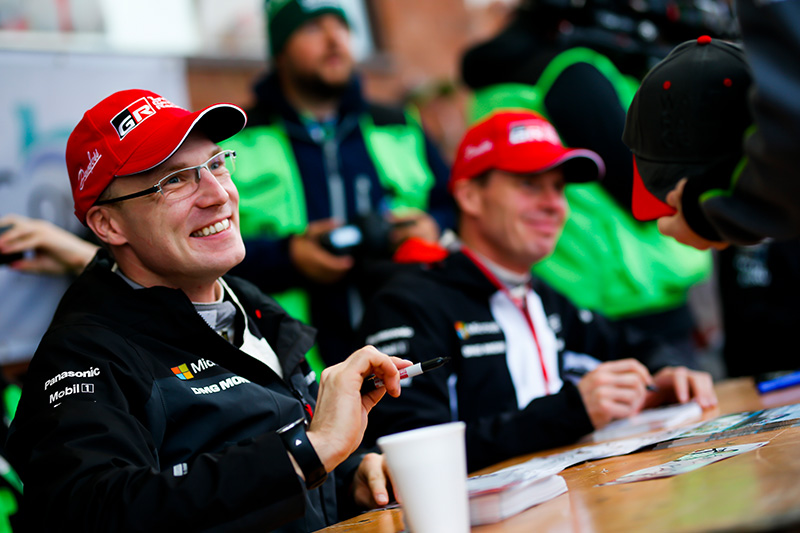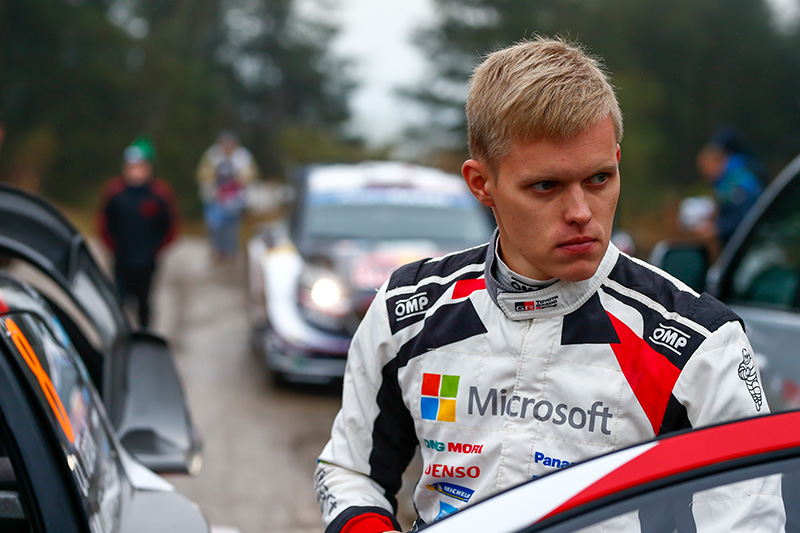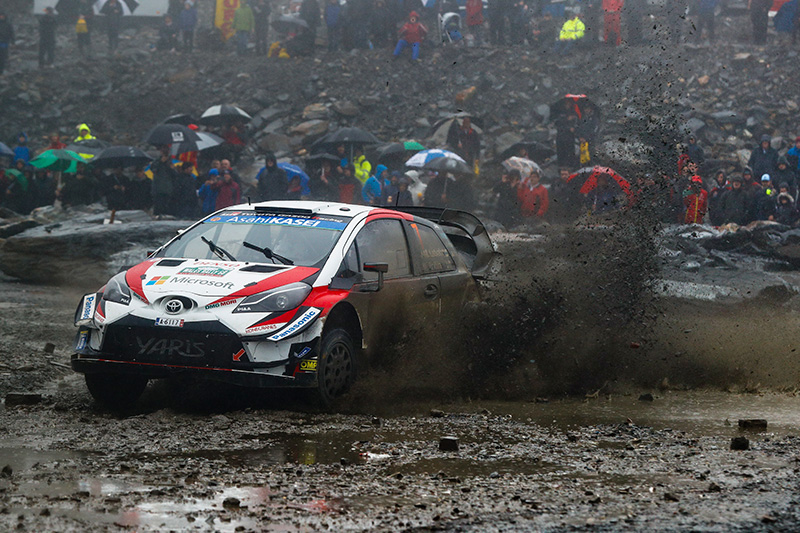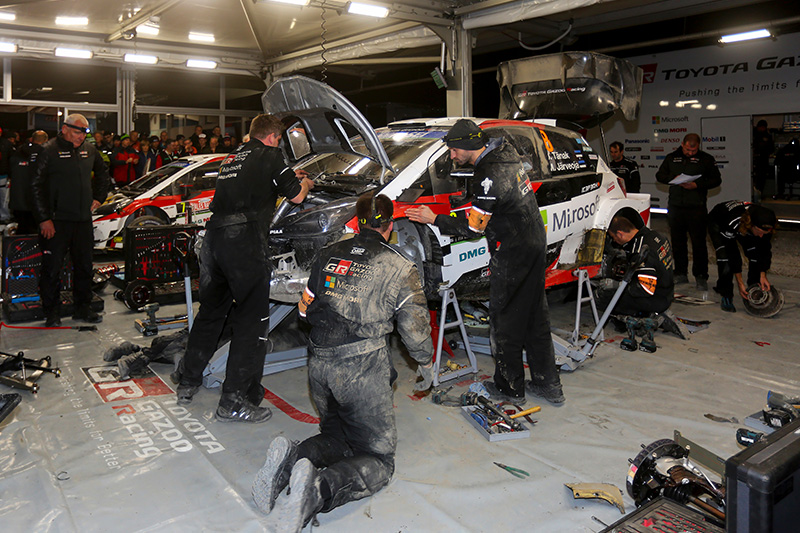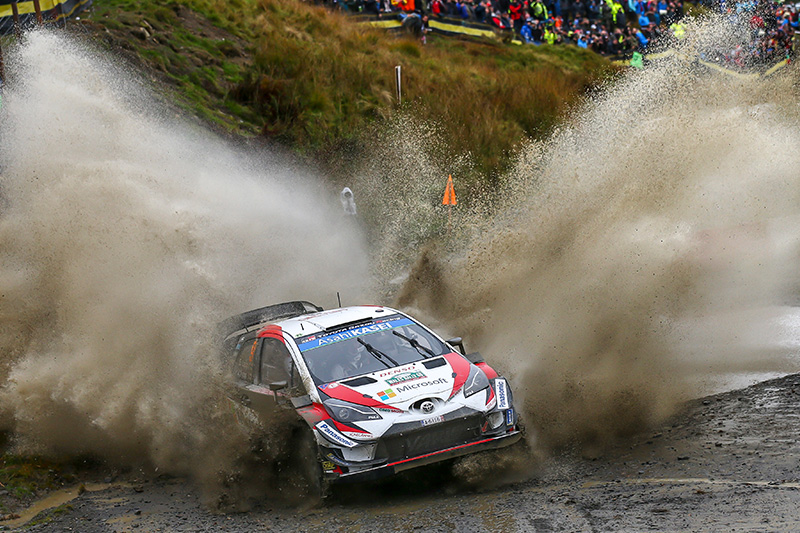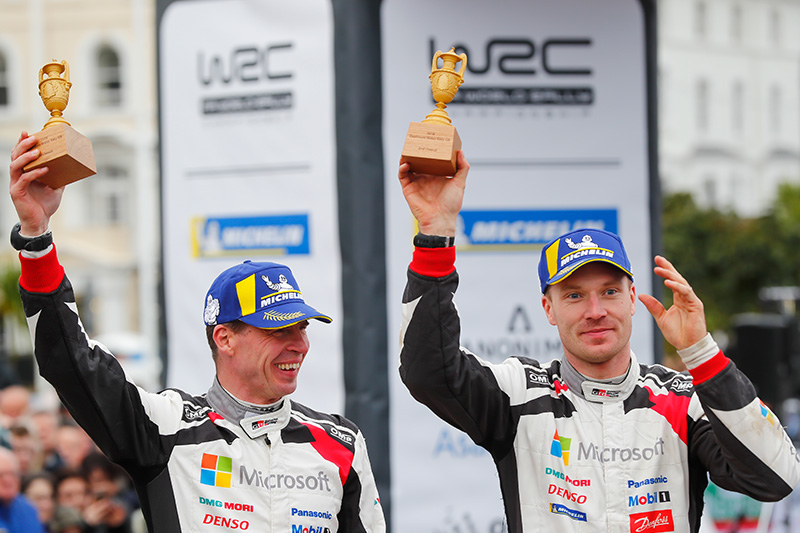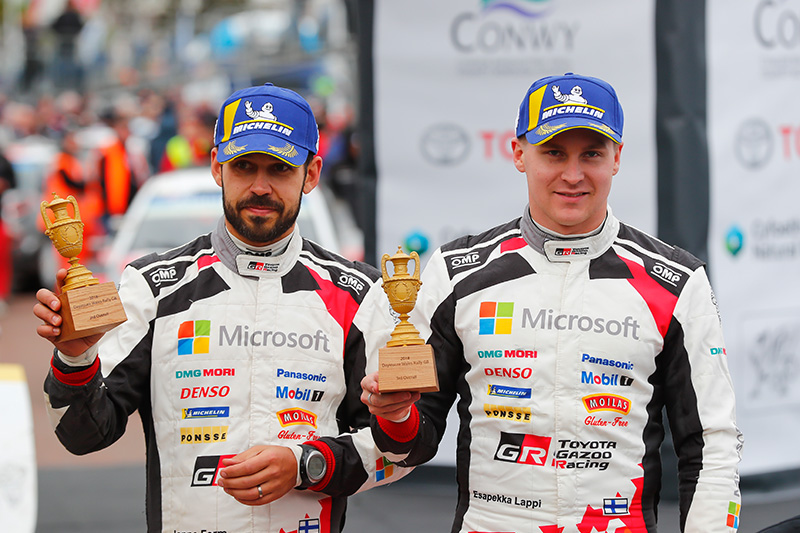RALLY GB
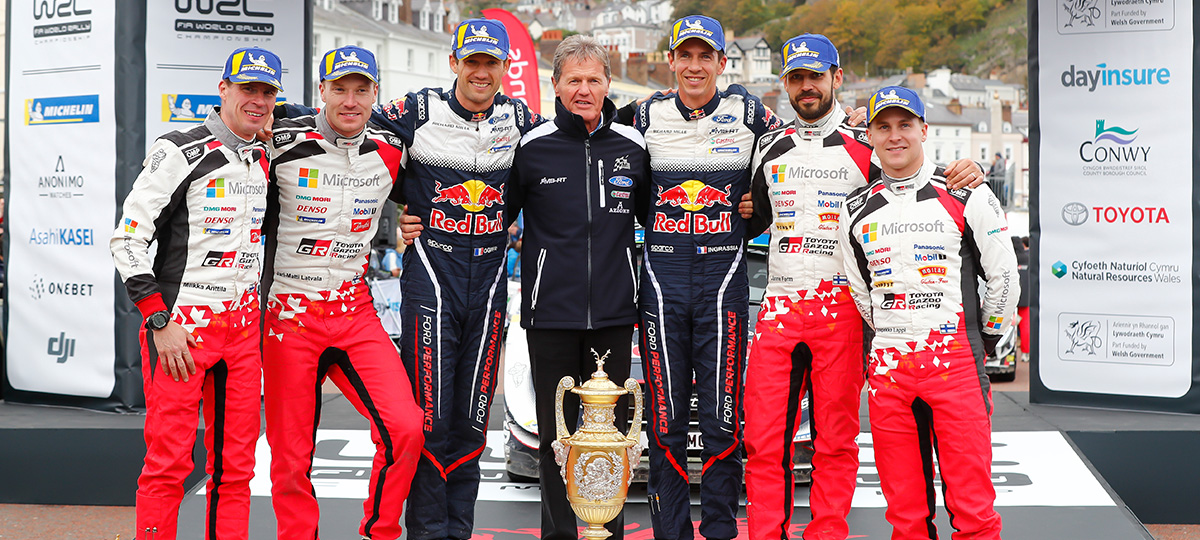
Last year, the Yaris WRC suffered a lack of grip on the muddy Welsh roads; the team secured a double podium finish this year, but were made aware of a need for further development
The Yaris WRC made its debut last season and demonstrated outstanding performance at high-speed rallies, securing victories in both Sweden and Finland. However, the car struggled at other events, exposing the team’s lack of actual rally experience: there were evidently many areas that needed to be improved. The Rally GB was one of those rallies.
The Rally GB is a traditional gravel rally held in Wales, in the United Kingdom. In autumn, the weather is unpredictable, and drivers frequently encounter rain and fog on the forest and hilly stages. The roads become muddy when they absorb lots of rain, leading to a significant decrease in grip; in such conditions, power from the engine is not transmitted efficiently to the road—in other words, it becomes difficult to generate traction. Last year, the Yaris WRC was unable to demonstrate its true potential on these roads, with Jari-Matti Latvala the best-placed TOYOTA GAZOO Racing World Rally Team driver, finishing in 5th place overall.
A considerable increase in traction on muddy roads
It would be impossible to challenge for victory at the Rally GB without resolving the lack of traction. The team learned a great deal at last year’s events, and had continued to make steady developments. In recent years, the WRC has imposed strict regulations on testing and, for this reason it is difficult for teams to test on the Welsh roads with any frequency. Last season’s pre-rally tests were conducted in almost dry conditions, whereas the rally itself was muddy. As a consequence, the setup the team had optimized at the tests did not function well during the rally itself. Fortunately, it rained during the pre-rally tests this year; Latvala and Ott Tänak spent an extended period of time driving on muddy surfaces, enabling the team to gather sufficient data. In the end, both drivers achieved satisfactory setups. Latvala confirmed the progress the Yaris WRC had made since last year: “Traction and handling have improved significantly. We should be able to drive with confidence even on muddy roads.” Both TOYOTA GAZOO Rally drivers started the 17th edition of the Rally GB full of belief.
Tänak is fastest on five SSs and ends Day Two in first place overall
October 4 was the opening day of the rally, and the first stage took place at a horse-racing track in the north of Wales. Esapekka Lappi secured the best time of the short SS, with Latvala finishing second. The drivers continued their good form on the forest stages of Day Two. Due to intermittent spells of rain across the first two days of the event, all the roads on Day Two were wet, with patches of mud. Featuring successions of twisting corners, the stages demanded powerful traction, and Tänak took victory in all three of the morning SSs. In the afternoon, he recorded fastest times on a further two stages and ended the day in first overall, holding a lead of 28.8 seconds over second place.
Tänak commented: “The Yaris WRC has made great progress on surfaces where it is difficult to find grip. The performance of the car is outstanding.” Following three successive victories in rounds 8, 9, and 10, the Estonian had risen to second in the drivers’ championship standings, with a gap of just 13 points to the leader. If he could achieve a strong result at the Rally GB, then Tänak would be within touching distance of the top.
Latvala and Lappi maintain their superb form, as the battle for the top three positions intensifies
Tänak was not the only TOYOTA GAZOO Racing driver to perform strongly on Day Two. Latvala also recorded stage wins as he ended the day in third place, just 2.5 seconds behind second. Lappi, whose pre-rally tests had largely taken place in dry conditions, struggled on the wet surfaces of the morning stages; however, after fine-tuning his setup, he succeeded in improving his pace. He finished the day in fourth position overall, 4.6 seconds behind his teammate Latvala.
At last year’s Rally GB, in addition to a lack of traction, the team had also encountered another problem: continued running in muddy conditions meant that mud stuck to every part of the Yaris WRC. This led to a considerable gain in car weight, with the cars picking up a maximum of more than 100 kilograms of mud. Since the back of the car were particularly susceptible to mud accumulation, the weight distribution of the Yaris WRC shifted rearwards. The front tires lost grip, and the team drivers had to contend with excessive understeer. The team had come up with countermeasures in the wake of last year’s struggles, and they proved a success. At this year’s Rally GB, the Yaris WRCs accumulated far less mud, and the impact on the handling of the cars was minimal.
Having looked untouchable in first place, Tänak suffers unexpected troubles
On Day Three, the rally moved to the center of Wales, where a succession of historic, popular stages were held. Tänak continued his fine form, and further widened his lead over second place with a series of secure drives. Indeed, at one point the gap was as much as 48 seconds—if he could continue in this manner, the Estonian would end Day Three with an extremely healthy lead.
However, in the afternoon on SS16, Tänak suddenly stopped, and was forced to retire for the day. The front-underside of his car had hit the ground hard, and the under guard had broken. The impact had also affected the radiator and caused cooling liquid to leak. Tänak had stopped his car in order to prevent damage to its engine, but there was nothing he could do mid-stage but retire for the day. As the victory that had appeared to be firmly in his grasp slipped away, Tänak looked to the heavens in frustration.
Latvala rises to second and Lappi to third overall
Latvala and Lappi had been involved in a fierce battle for the top three, and each rose a place in the rankings following Tänak’s retirement for the day; the former ended Day Three in second and the latter in third overall. The two teammates had continued their strong performances on Day Three of the rally, with Latvala securing two SS victories; unfortunately, however, his engine stalled at the hairpin corner of the final stage of the day, resulting in the loss of a few precious seconds. The Yaris WRC had previously suffered from engine stall on tight corners, and the team had therefore acted to prevent its recurrence; but this was an incident when unique conditions conspired to result in a rare loss of engine speed. At the end of Day Three, the gap between Latvala in second and Sébastien Ogier in first was just 4.4 seconds. In such a tight battle, the few seconds Latvala lost through his stalled engine were proving significant. The team therefore resolved to find a comprehensive solution to the problem.
Latvala and Ogier engage in a fierce fight for victory
Day Four, the final day of the rally, comprised five short SSs covering a total distance of 55.64 kilometers. If he wanted to close the 4.4-second gap on World Champion Ogier, Latvala had no choice but to attack fully from the first special stage of the day. On the other hand, given TOYOTA GAZOO Racing’s position in the manufacturers’ championship, there was no way he could give up potential points through retirement. Latvala therefore started the day in extremely trying circumstances. On SS19, the first stage of Day Four, he recorded the second fastest time after teammate Lappi; he then went fastest on SS20 with a full-blooded attack, finally overtaking Ogier and creating a gap of 3.6 seconds at the top of the standings. Stage 20 was also the designated Power Stage and, as a result, Latvala succeeded in securing the maximum five bonus points on offer. Tänak, who had rejoined the rally on Day Four according to the Rally 2 Regulations, finished second to score four bonus points.
Latvala was close to claiming his first victory of the season, but Ogier proved to be a formidable opponent. The Frenchman first closed the gap on SS21, a tarmac stage that followed a series of cliffs, then retook the lead on SS22. SS22 was, in fact, a rerun of SS20 but, having chosen tires that were suboptimal for the surface conditions, Latvala was two seconds slower than he had been earlier in the day. Unable to overturn the deficit to first place on the final stage of the rally, the Finn had to settle for his second successive second place. Although he had not been able to clinch victory, Latvala was content both with the evolution of the Yaris WRC and the improvement in his own performance. He smiled as he took to the podium and congratulated the winner. Day Four had seen a battle between two world-class drivers and was a fitting conclusion to this traditional rally, which could be one of the battles to be remembered.
Lappi finished third overall and took the final spot on the podium. This was his third third-place finish of the season, the team’s fourth double podium in succession, and fifth in total this year. As a result, TOYOTA GAZOO Racing extended its lead at the top of the manufacturers’ championship; however, due to Tänak’s retirement, the team was not entirely satisfied with its results.
Despite demonstrating world-class speed, as an overall package the Yaris WRC continues to show weaknesses
Victory had also eluded Tänak in Round Seven, the Rally Italia Sardegna, due to a similar issue. The team had, of course, implemented countermeasures after the event in Italy, but in hindsight they may have been insufficient. The cars of the other two team drivers encountered no such troubles, and no problems had afflicted any of the car at the Rally of Turkey either, where surface conditions had been even worse than in Wales. The terminal impact on Tänak’s Yaris WRC may simply have been a freak occurrence; yet, if the team wants to ensure there are no repeats of such a problem, further improvements are necessary. If it were just a matter of increasing the toughness of the car, then changes—such as increasing the thickness of the under guard or expanding the area it protects—would not be difficult to implement. However, such modifications unavoidably lead to an increase in car weight, change the distribution of weight around the car, and thereby have the potential to influence the handling of the car. Instead, the team must strike the optimal balance between performance and durability. Following the conclusion of the rally, Chief Engineer Tom Fowler immediately began drawing up plans to improve the Yaris WRC.
The fight for the championship looks set to go down to the final round in Australia
Tänak only managed to score four points—due to his second place in the Power Stage—at the Rally GB, and dropped to third overall in the drivers’ championship. The gap to Thierry Neuville in first now stands at 21 points. Although the odds are firmly stacked against him, Tänak expressed his determination to fight to the very end: “I will continue to battle as best I can until the final stage of the final rally in Australia has finished.” All the members of the TOYOTA GAZOO Racing World Rally Team will continue to do their utmost as they seek both to secure the manufacturers’ championship and to aid Tänak in his quest for victory.
RESULT
| Pos | Driver | Co-Driver | Vehicle | Time |
|---|---|---|---|---|
| 1 | Sebastien Ogier | Julien Ingrassia | Ford Fiesta WRC | 3h06m12.5s |
| 2 | Jari-Matti Latvala | Miikka Anttila | Toyota Yaris WRC | +10.6s |
| 3 | Esapekka Lappi | Janne Ferm | Toyota Yaris WRC | +35.1s |
| 4 | Craig Breen | Scott Martin | Citroen C3 WRC | +1m10.4s |
| 5 | Thierry Neuville | Nicolas Gilsoul | Hyundai i20 Coupe WRC | +1m14.4s |
| 6 | Andreas Mikkelsen | Anders Jaeger | Hyundai i20 Coupe WRC | +1m15.9s |
| 7 | Hayden Paddon | Seb Marshall | Hyundai i20 Coupe WRC | +1m18.4s |
| 8 | Mads Ostberg | Torstein Eriksen | Citroen C3 WRC | +1m21.6s |
| 9 | Kalle Rovanpera | Jonne Halttunen | Skoda Fabia R5 | +9m14.7s |
| 10 | Pontus Tidemand | Jonas Andersson | Skoda Fabia R5 | +10m48.9s |
| 19 | Ott Tänak | Martin Järveoja | Toyota Yaris WRC | +20m38.9s |


